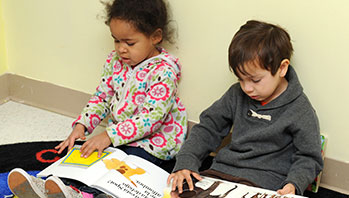- book-browsing boxes
MA Standards:
English Language Arts/Foundational Skills/RF.PK.MA.1.a: Handle books respectfully and appropriately, holding them right-side-up and turning pages one at a time from front to back.
Head Start Outcomes:
Literacy Knowledge/Book Appreciation and Knowledge: Shows interest in shared reading experiences and looking at books independently.
Literacy Knowledge/Book Appreciation and Knowledge: Recognizes how books are read, such as front-to-back and one page at a time, and recognizes basic characteristics, such as title, author, and illustrator.
Social Emotional Development/Self-Concept and Self-Efficacy: Identifies personal characteristics, preferences, thoughts, and feelings.
Social Emotional Development/Self-Concept and Self-Efficacy: Demonstrates age-appropriate independence in a range of activities, routines, and tasks.
PreK Learning Guidelines:
English Language Arts/Reading and Literature 10: Engage actively in read-aloud activities by asking questions, offering ideas, predicting or retelling important parts of a story or informational book.
Health Education 19: Practice independence and self-help skills.
Independent and Partner Reading, Unit 5, Week 2

© Commonwealth of Massachusetts, Department of Early Education and Care (Jennifer Waddell photographer). All rights reserved.
Skill Focus: Book Appreciation, Book Care and Handling, Concepts of Print, Speaking and Listening, Vocabulary
Encourage children to select books that interest them and to look at the words and pictures on their own or with other children.
- Read aloud the title. Then ask the child to tell you about the book he or she has selected.
- Invite the child to turn the pages to show his or her favorite parts of the book. Praise him or her for turning the pages gently and handling the books with care.
If children select a nonfiction book, ask them to show you their favorite picture in the book. Read the accompanying text or caption aloud.
- Talk about different ways of reading and using nonfiction books.
- Point out and talk about nonfiction features, like a table of contents, index, glossary, charts, or picture captions.
